The Boiling Conspiracy
TL;DR
Meat can be cooked safely at well below 100C, and comes out better for it, so why do cook books and TV chefs never suggest it?
Background
I love to eat and I love to cook, which is one of the reasons that I made my own temperature controlled sous vide water bath – so that I could experiment with new cooking styles.
Today’s Sunday Roast was beef brisket that I cooked for 16 hours at 88C (190F). The gravy that I made with the juices was so nice that my wife finished off what was left over with a spoon.

Low and Slow
Using the water bath has encouraged me to try other low temperature cooking methods. I frequently roast leg of lamb or pork belly in a fan oven overnight at around 75C, which brings me to the point – for me the low in ‘low and slow’ is generally below 100C – I don’t boil my food for hours on end.
But I’ve never, ever seen a TV chef or cook book (apart from the excellent Cooking for Geeks) suggest roasting at anything less than 100C (and generally a good margin above that), and with higher temperatures come quicker cooking times, so ‘slow and low’ becomes neither.
It’s an artefact of human history that there were two ways to make water safe to drink:
- Boiling
- Alcohol
Of course neither come into play in the modern first world, where we get safe drinking water at the twist of a tap that doesn’t need boiling. It seems however that 100C has become a magical number for food safety that nobody in the public eye is willing to go below.
If I look at official guidance (such as this from the Canadian government) it ranges from 63C for beef steaks to 82C for whole poultry – all comfortably below 100C. These are of course internal temperatures, so with normal high temperature roasting we might go for an hour or two at 180C or more externally to get to the required internal temperature; but with ‘low and slow’ then (given enough time) the internal temperature becomes the same as the external temperature. This happens quicker with a water bath (which uses conduction) than an over (which uses convection), but given sufficient time (which is the whole point) the outcome is the same.
I strongly suspect that the ‘low and slow’ of earlier generations, before the advent of modern ovens, was generally below 100C – so I expect that we’re just rediscovering the delights of how my grandparents used to get their Sunday roasts (when they were lucky enough to have meat).
There’s an important point here – water turns to steam at 100C and meat dehydrates, so proper ‘low and slow’ results in moist and tender meat, which is why I find it such a mystery that all the modern recipes advise above 100C. My guess is that the TV chefs use proper low temperatures for their own cooking, but are too scared to bring the general public along with them in case some fool messes it up and poisons themselves (and their family).
Filed under: cooking | 2 Comments
Tags: boiling, cooking, roasting, Sous vide, temperature
Chris, have you put any thought into th erelative energy consumption of cooking “low and slow” vs “fast and hot”?
It’s not something I’ve put much thought into.
I have plenty of data for the sous vide cooking, so it would be relatively straightforward for me to calculate the cost of energy for that approach.
Getting the comparative oven usage will likely be less scientific, but I have an energy monitor that could be used to get me decent estimates.
My guess is that ‘low and slow’ probably costs me more (as I could just stick the meat in the oven with the roast potatoes etc. if I was going ‘fast and hot’) but that the energy costs are insignificant.
Here’s a quick estimate… using the 200w water bath for a duty cycle of 5s/min over 12 hrs works out at 0.2kWh so at 15p/kWh that would be 3p of energy, which I’m happy to call trivial and ignore.